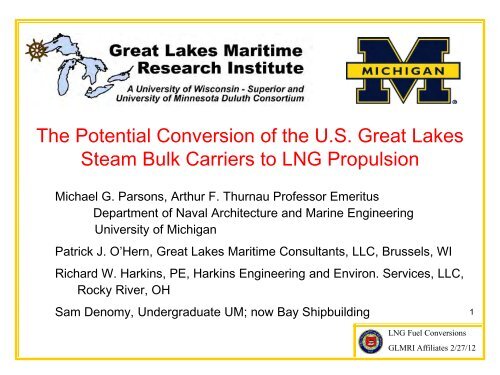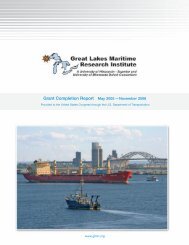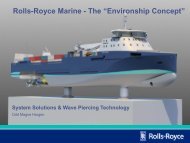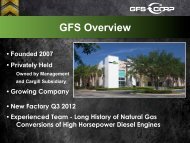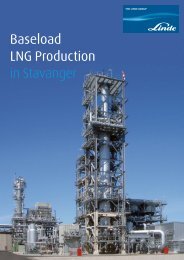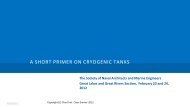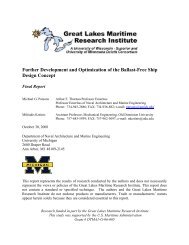Steam Bulk Carrier LNG Conversion Study - Great Lakes Maritime ...
Steam Bulk Carrier LNG Conversion Study - Great Lakes Maritime ...
Steam Bulk Carrier LNG Conversion Study - Great Lakes Maritime ...
Create successful ePaper yourself
Turn your PDF publications into a flip-book with our unique Google optimized e-Paper software.
The Potential <strong>Conversion</strong> of the U.S. <strong>Great</strong> <strong>Lakes</strong><strong>Steam</strong> <strong>Bulk</strong> <strong>Carrier</strong>s to <strong>LNG</strong> PropulsionMichael G. Parsons, Arthur F. Thurnau Professor EmeritusDepartment of Naval Architecture and Marine EngineeringUniversity of MichiganPatrick J. O’Hern, <strong>Great</strong> <strong>Lakes</strong> <strong>Maritime</strong> Consultants, LLC, Brussels, WIRichard W. Harkins, PE, Harkins Engineering and Environ. Services, LLC,Rocky River, OHSam Denomy, Undergraduate UM; now Bay Shipbuilding1<strong>LNG</strong> Fuel <strong>Conversion</strong>sGLMRI Affiliates 2/27/12
Goals of Project• Conceptual designs of <strong>LNG</strong> conversion for 10 remainingsteam powered bulk carrierssee: Parsons, O’Hern, and Denomy, “The Potential <strong>Conversion</strong> of the U.S. <strong>Great</strong> <strong>Lakes</strong><strong>Steam</strong> <strong>Bulk</strong> <strong>Carrier</strong>s to Liquefied Natural Gas Propulsion – Initial Report,” Journal ofShip Production and Design, Aug. 2012.• Evaluate fuel cost and air emissions• Prepare shipyard conversion plan• Estimate overall economics and payback periods• Organize and lead trip to observe Norwegian <strong>LNG</strong> use<strong>LNG</strong> Fuel <strong>Conversion</strong>s2GLMRI Affiliates 2/27/12
Outline• Vessels under consideration• Emission Control Area (ECA) emissions• Advantage of conversion to <strong>LNG</strong> fuel• Challenges in using <strong>LNG</strong> fuel• Conceptual design for AAA <strong>LNG</strong> conversions– Fuel use comparison and tank sizing– Air emissions comparison– Arrangement feasibility• Conclusions3<strong>LNG</strong> Fuel <strong>Conversion</strong>sGLMRI Affiliates 2/27/12
U.S. Flag <strong>Great</strong> <strong>Lakes</strong> <strong>Steam</strong> <strong>Bulk</strong> <strong>Carrier</strong>sTen remaining U.S. Flag steam bulk carriersThree, the AAA Class, are to the same design – initial and primary focus<strong>LNG</strong> Fuel <strong>Conversion</strong>s4GLMRI Affiliates 2/27/12
Emission Control Area (ECA)• In place for the Baltic Sea and North Sea• North American ECA became enforceable in August 2012• ECA includes non-Arctic coastal and inland watersof the U.S., Canada and Saint Pierre & Miquelon• Lower marine fuel sulfur and NOx requirements<strong>LNG</strong> Fuel <strong>Conversion</strong>s5GLMRI Affiliates 2/27/12
MARPOL (EPA) Marine Fuel Sulfur LimitsAlternative: use exhaust gas scrubbers (NaOH, weight, space, labor,cost, discharge)1% S differential for IF running $50-90/t in Rotterdam<strong>LNG</strong> Fuel <strong>Conversion</strong>s6GLMRI Affiliates 2/27/12
MARPOL (EPA) ECA NOx Emissions Limits80 % Reduction<strong>Conversion</strong>s andnew constructionDiesels will require Selective Catalytic Reduction (SCR) for Tier III(aqueous urea, weight, space, labor, cost )7<strong>LNG</strong> Fuel <strong>Conversion</strong>sGLMRI Affiliates 2/27/12
Status of Emission Control Area (ECA)Air Emissions RequirementsStatus• Fuels must be available• Congressionally mandatedGL steamship exemptionPremise for study:Not coming up to EPAECA emissions standardsis not sustainable in thelong run• EPA offer for streamlinedconversion to diesel, withS waiver to permit burningIFO to 2026 without scrubber8<strong>LNG</strong> Fuel <strong>Conversion</strong>sGLMRI Affiliates 2/27/12
Reasons to Consider <strong>LNG</strong> <strong>Conversion</strong>s• <strong>LNG</strong> cargo carriers use cargo burn-off for fuel (steam, then diesel)approaching 240 vessels; over 40 years experience(classification by ABS, DNV, others)• Beginning in 2000 with the ferry Glutra, first non-<strong>LNG</strong> cargo vesselthese <strong>LNG</strong> vessels, mostly in Norway (DNV), now approaching 30• Recent conversion of a 5 year old 25,000 DWT producttanker Bit Viking from HFO to <strong>LNG</strong> in atwo month conversion (DNV)• Harvey Gulf International contracted for4 <strong>LNG</strong> powered offshore supply vessels(first US flag, ABS, U.S. Coast Guard) 9<strong>LNG</strong> Fuel <strong>Conversion</strong>sGLMRI Affiliates 2/27/12
Advantages of using <strong>LNG</strong> Fuel• <strong>Great</strong>er propulsion efficiency – almost 85% better• Potential reduced fuel cost (on an energy equiv. basis)IFO 180 $2.30/gallon <strong>LNG</strong> equiv. $2.50/gallon (WSF 2014 pred.)MDO $2.90/gallon <strong>LNG</strong> equiv. $2.18/gallon<strong>LNG</strong> predicted to be more stable and flatter into the future• Reduced air emissions - without the need for scrubber/NaOHor Selective Catalytic Reduction(SCR)/aqueous urea to meetECA requirements• Potential reduced manning – up to 1 officer and 3 crew• Cleaner, quieter, lower maintenance<strong>LNG</strong> Fuel <strong>Conversion</strong>s10GLMRI Affiliates 2/27/12
Plant Configuration• Two P/S 159 cubic m useable volume <strong>LNG</strong> tanksseparate & duplicate <strong>LNG</strong> tanks, cold boxes, and Gas Valve Units• Single fuel or dual fuel gas main engineRolls-Royce Bergen B35:4012VG engine (5400 kW)or Wärtsilä 12V34DF engine (5400 kW)• CRP propeller driven through single reduction gear• Two Cat diesel generators to replace steam turbogeneratorsCat C18 ACERT 60 Hz 550 kWe @ 1800 rpm• Two new gas or dual fuel auxiliary boilers• No change to vessels forward of FR 18313<strong>LNG</strong> Fuel <strong>Conversion</strong>sGLMRI Affiliates 2/27/12
Assumed Round Trip Voyage Duluth to GaryRe: Parsons, M. G., Singer, D. J. and Denomy, S. J. 2011 Integratedelectric plants in future <strong>Great</strong> <strong>Lakes</strong> self-unloaders, Journal ofShip Production and Design, 27, 4, 169-185.<strong>LNG</strong> Fuel <strong>Conversion</strong>s14GLMRI Affiliates 2/27/12
Annual Fuel Cost ComparisonRolls-Royce Wärtsilä MaKB35:40V12PG 12V34DF 6M43CEPA waiver<strong>LNG</strong> Fuel <strong>Conversion</strong>s15GLMRI Affiliates 2/27/12
Tank Sizing and Endurance• Chart Ferox, a.s., Decin, Czech Republic• Vertical tank designs with cold box below within skirt– VTS 261/8 261 cubic m; 8 bar– VTS 199/8 199 cubic m; 8 bar tank 17.5’ OD; 43’ tall• Using two shorter tanks– with a15% head space when filling; 5% cooling margin– net useable tank volume = 159.2 cubic m each• Endurance– single fuel: bunkering once per round trip with 61% margin– dual fuel: bunkering once per round trip with 56% margin– ~9 days of operations; ~6 on diesel only 16<strong>LNG</strong> Fuel <strong>Conversion</strong>sGLMRI Affiliates 2/27/12
Annual Air Emissions Comparison[metric tonnes/year - after January 1, 2015]Rolls-Royce Wärtsilä MaKB35:40V12PG 12V34DF 6M43C<strong>LNG</strong> Fuel <strong>Conversion</strong>s17GLMRI Affiliates 2/27/12
AAA Single Fuel <strong>Conversion</strong> Inboard ProfileP/S<strong>LNG</strong> Fuel <strong>Conversion</strong>s18GLMRI Affiliates 2/27/12
AAA Single Fuel <strong>Conversion</strong> Poop Deck<strong>LNG</strong> Fuel <strong>Conversion</strong>s19GLMRI Affiliates 2/27/12
AAA Single Fuel <strong>Conversion</strong> Spar Deck<strong>LNG</strong> Fuel <strong>Conversion</strong>s20GLMRI Affiliates 2/27/12
AAA Single Fuel <strong>Conversion</strong> Main Deck<strong>LNG</strong> Fuel <strong>Conversion</strong>s21GLMRI Affiliates 2/27/12
AAA Single Fuel <strong>Conversion</strong> Operating Deck<strong>LNG</strong> Fuel <strong>Conversion</strong>s22GLMRI Affiliates 2/27/12
AAA Single Fuel <strong>Conversion</strong> Tank Top<strong>LNG</strong> Fuel <strong>Conversion</strong>s23GLMRI Affiliates 2/27/12
AAA Dual Fuel <strong>Conversion</strong> Inboard ProfileMaK 6M46C DF 1.64 m longer, not feasibleengine 0.6 m longer, moved aft<strong>LNG</strong> Fuel <strong>Conversion</strong>s24GLMRI Affiliates 2/27/12
AAA Dual Fuel <strong>Conversion</strong> Operating Deck<strong>LNG</strong> Fuel <strong>Conversion</strong>s25GLMRI Affiliates 2/27/12
Conclusions and PlansConclusions• The availability of <strong>LNG</strong> at anappropriate price will be criticalto the economic viability ofconversion to <strong>LNG</strong> fuel ratherthan conversion to diesel.• The other challenges appearto be workable.Next tasks for AAA class• Weight/stability study• Shipyard planning/cost• Life-cycle cost/paybackTransferability to othervessels• The arrangement of the AAA<strong>LNG</strong> conversions to ABS/DNVrequirements appears feasible.<strong>LNG</strong> Fuel <strong>Conversion</strong>s26GLMRI Affiliates 2/27/12
AcknowledgementsGLMRI study funded through a grant funded by theU. S. Department of TransportationOffice of the Secretary and the <strong>Maritime</strong> Administration(Grant #DTMA1H11002).<strong>LNG</strong> Fuel <strong>Conversion</strong>s27GLMRI Affiliates 2/27/12
Special Thanks to• Mark Barker, Interlake <strong>Steam</strong>ship Co.• Noel Bassett, American <strong>Steam</strong>ship Co.• Mitch Koslow, Keystone Shipping Co.• Leslee Hallas & Claus Emmers, Chart Industries, Inc.• Jan Kubica & Joris van Kreij, Chart Ferox, a.s., Decin, Czech Republic• Michael Hitt, Odd Horgen, Jakob Nielsen, & Sindre Haberg, Rolls-Royce Bergen• John Hatley, Paul Glandt, & Pete Jacobs, Wärtsilä North America, Inc.• Ken Westcar, Toromont Cat Power Systems• Rolf Fiskerstrand & Ronny Kristiansen, Fiskerstrand Verft, Alesund, NO• Oscar Bergheim & officers and crew of Raunefjord, Fjord1• Oystein Djupvik & Peter Husoy, Kleven Verft, Ulsteinvik, NO• Jan Fredrick Meling, Helge Vespestad & other officers and crew of Viking Princess,Eidesvik, Bomlo, NO• Michael Aasland, Marius Leisner & Lars Blikom, Det Norske Veritas, Hovik, NO• Lasse Karlsen & Oyvind Vormedal , Norwegian <strong>Maritime</strong> Authority, Haugesund, NO<strong>LNG</strong> Fuel <strong>Conversion</strong>s28GLMRI Affiliates 2/27/12
Thank you.Questions?<strong>LNG</strong> Fuel <strong>Conversion</strong>s29GLMRI Affiliates 2/27/12
Lean Burn Gas Engine Operation30courtesy of Wärtsilä<strong>LNG</strong> Fuel <strong>Conversion</strong>sGLMRI Affiliates 2/27/12
Two Gas Engine Concepts in Use TodaySingle-fuel installationsSingle-fuel spark ignited Otto cyclee.g. Rolls-Royce Bergen enginesDual-fuel installationsDual-fuel diesel pilot ignited Otto cyclee.g. Wärtsilä and MaK engines~1% power from Diesel cycle micro pilotcan also run on just diesel as a back-upexhaust stroke not showncourtesy Wärtsilä<strong>LNG</strong> Fuel <strong>Conversion</strong>sGLMRI Affiliates 2/27/12


